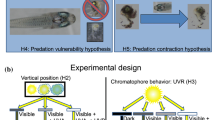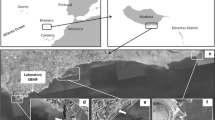Abstract
Different high-Arctic, freshwater localities at Ny-Ålesund, Svalbard (79dgN) were examined for their UV-absorbing properties, depth and presence of melanic Or non-melanic morphs of the planktonic crustaceanDaphnia pulex. Light regimes in two localities with each of these morphs were measured by using underwater spectroradiometer. Most localities have low absorbance of short-waved light, but no clearcut relationship between UV transparency and occurrence of melanic morphs was detected. Yet, in the laboratory, the melanic morph showed far lower growth rates, thus being competitively inferior to the non-melanic. Conversely, the melanic morph was more resistant to UV light, suggesting a trade-off between the metabolic tax paid for the melanin synthesis and its UV-protecting abilities, or a staggered growth capacity possibly owing to polyploidy. Frequency of melanic or non-melanic clones could thus be directly linked to ambient UV-B stress and serve as an indicator thereof, but the apparently extensive need for UV protection under the Arctic lighl regimes is still puzzling, and the role of melanism and polyploidy in these organisms cannot be considered finally settled.
Similar content being viewed by others
References
Beaton MJ, Hebert PDN (1988) Geographical parthenogenesis and polyploidy inDaphnia pulex. Am Nat 132:837–845
Beatty RA (1957) Parthenogenesis and polyploidy in mammalian development. Vambridge Monographs in Experimental Biology, no 7. Cambridge University Press, London
Blois MS (1988) The melanins, their synthesis and structure. In: Smith KC (ed) Photochemical and photobiological reviews, vol 3. Plenum Press, New York, pp 115–133
Brooks JL (1957) The systematics of North AmericanDaphnia. Mem Conn Acad Arts Sci 13:5–180
Byro ER (1979) The adaptive significance of Zooplankton pigmentation: a new hypothesis. Abstr Bull Ecol Soc Am 60:79
Dahlback A, Stamnes K (1991) A new spherical model for computing the radiation field available for photolysis and heating at twilight. Planet Space Sci 39:671–683
Dahlback A, Henriksen T, Larsen SHH, Stamnes K (1989) Biological UV-doses and the effect of an ozonelayer depletion. Photochem Photobiol 49:621–625
Hairston NG Jr (1978) Carotenoid photoprotection inDiaptomus kenai. Verh Int Verein Limnol 20:2541–2545
Hairston NG Jr (1979) The adaptive significance of color polymorphism in two species ofDiaptomus (Copepoda). Limnol Oceanogr 24:15–37
Hairston NG Jr (1981) The interactions of salinity, predators, light and copepod color. Hydrobiologia 81:151–158
Hebert PDN, Emery CJ (1990) The adaptive significance of cuticular pigmentation inDaphnia. Func Ecol 4:703–710
Hebert PDN, McWalter DB (1983) Cuticular pigmentation in arcticDaphnia: adaptive diversification of asexual lineages. Am Nat 122:286–291
Hessen DO (1993) DNA-damage and pigmentation in alpine and arctic zooplankton as bioindicators of UV-radiation. Verh Int Verein Limnol 25:482–486
Hessen DO (1994)Daphnia responses to UV-light. Arch Hydrobiol Bech Ergebn Limnol 43:185–195
Hessen DO, Sørensen K (1990) Photoprotective pigmentation in alpine Zooplankton populations. Aqua Fenn 20:165–170
Hobæk A, Wolf HG (1991) Ecological genetics of NorwegianDaphnia. II. Distribution ofDaphnia longispina in relation to shortwave radiation and water colour. Hydrobiologia 225:229–243
Hobæk A, Weider LJ, Wolf HG (1993) Ecological genetics of NorwegianDaphnia. III. Clonal richness in an apomictic complex. Heredity 71:323–330
Kerr JB, McElroy CT (1993) Evidence for large upwards trends of ultraviolet-B radiation linked to ozone depletion. Science 262:1032–1034
Kirk JTO (1994) Optics of UV-B radiation in natural waters. Arch Hydrobiol Beih Ergebn Limnol 43:1–16
Lewis WH (ed) (1980) Polyploidy: biological relevance. Basic Life sciences, vol 13. Plenum Press, New York
Löffler H (1969) High altitude lakes in the Mt. Everest region. Verh Int Verein Limnol 17:373–385
Luecke C, O'Brien WJ (1983) Photoprotective pigmentation in a pond morph ofDaphnia middendorffiana. Arctic 36:365–368
Lynch M (1984) Destabilizing hybridization, general pupose phenotypes and geographic parthenogenesis. Q Rev Biol 59:257–290
Lynch M, Weider LJ, Lampert W (1986) Measurements of the carbon balance inDaphnia. Limnol Oceanogr 31:17–33
Madronich S, McKenzie RL, Caldwell MM, Björn LO (1995) Changes in the ultraviolet radiation reaching the earth's surface. Ambio 24:143–152
McKinley AF, Diffey BL (1987) A reference action spectrum for ultraviolet induced erythema on human skin. Commission Internationale de l'Eclaire: 17–22
Ringelberg J, Keyser AL, Flik BJG (1984) The mortality of ultraviolet radiation in a translucent and in a red morph ofAcanthodiaptomus denticornis (Crustacea, Copepoda) and its possible ecological significance. Hydrobiologia 112:217–222
Siebeck O (1978) Ultraviolet tolerance of planktonic crustaceans. Verh Int Verein Limnol 20:2469–2473
Siebeck O, Böhm U (1994) Challenges for an appraisal of UV-B effects upon planktonic crustaceans under natural radiation conditions with a non-migrating (Daphnia pulex obtusa) and a migrating cladoceran (Daphnia galeata). Arch Hydrobiol Beih Ergebn Limnol 43:197–206
Spitz DR, Mackey MA, LiGC Elwell JH, McCormick ML, Oberley LW (1989) Relationship between changes in ploidy and stable cellular resistance to hydrogen peroxide. J Cell Physiol 139:592–598
Ward RM, Bickerton T, Finston T, Hebert PDN (1994) Geographical cline in breeding systems and ploidy levels in European populations ofDaphnia pulex. Heredity 73:532–543
Weider LJ (1987) Life history variation among low-arctic clones of obligately parthenogeneticDaphnia pulex; a diploid-polyploid complex. Oecologia Berlin 73:251–256
Weider LJ, Hobaek A (1994) Molecular biogeography of clonal lineages in a high-Arctic apomicticDaphnia complex. Mol Ecol 3:497–506
Weider LJ, Beaton MJ, Hebert PDN (1987) Clonal diversity in high-arctic populations ofDaphnia pulex, a polyploid apomictic complex. Evolution 41:1335–1346
Wolf HG, Hobaek A (1986) Ecological genetics of NorwegianDaphnia. I. Genetic difference between between pigmented and unpigmented alpine pond populations. Hereditas 104:193–198
Author information
Authors and Affiliations
Rights and permissions
About this article
Cite this article
Hessen, D.O. Competitive trade-off strategies in ArcticDaphnia linked to melanism and UV-B stress. Polar Biol 16, 573–579 (1996). https://doi.org/10.1007/BF02329054
Received:
Accepted:
Issue Date:
DOI: https://doi.org/10.1007/BF02329054




